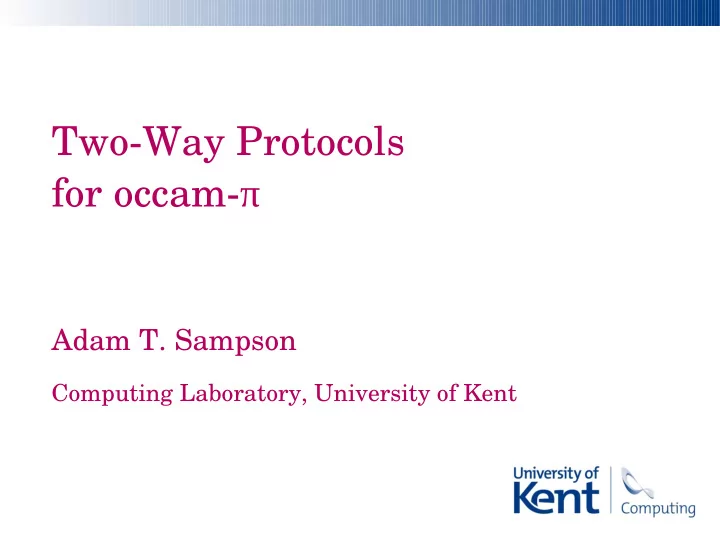

Two-Way Protocols for occam- π Adam T. Sampson Computing Laboratory, University of Kent
Before we start... ● This is a proposal – It hasn't yet been implemented ● It's a synthesis of several existing ideas ● It's applicable to a variety of process-oriented languages and libraries – so when I say “occam”, read “occam or JCSP or CHP or PyCSP or ...” 2
The problem 3
Processes and channels ● In occam, we build programs by composing processes connected by synchronous, unidirectional channels read.file decode display 4
Protocols ● The messages that may be sent over a channel are defined by a protocol ● The compiler checks that the program follows the protocol PROTOCOL POSITION IS INT; INT: PROTOCOL VIDEO.STREAM CASE frame; TIME; [][]PIXEL end.of.stream : 5
Clients and servers ● A common design pattern: server server processes answer requests from client processes requests responses ● Design rules can be used to construct client complex client-server networks safely 6
Conversations ● Each interaction between a client and server is a conversation , and may contain any number of messages ● For example, the loan pattern : – Client: “Let me borrow your big data structure.” – Server: “OK, here it is.” – Client: “Right, I'm done; you can have it back now.” 7
Client-server in occam ● Request and response channels have separate protocols PROTOCOL LOAN.REQ CASE borrow return; MOBILE DATA : PROTOCOL LOAN.RESP CASE lend; MOBILE DATA : 8
Safety assured? ● We can check the protocol on each individual channel ● But: – Client: “Let me borrow your big data structure.” – Server: “OK, here it is.” – (Client gets distracted and wanders off.) – Client: “Let me borrow your big data structure.” – ( Boom! ) 9
What went wrong? ● Each channel's protocol is checked, but the overall conversation is not checked – ... so it's possible for the client and server to get into an inconsistent state ● We need a way of describing the two-way protocol that the client and server follow – This is useful for documentation too! 10
Some existing approaches 11
Honeysuckle (Ian East) ● Language for engineering client-server systems ● A compound service defines the interface to a server using simplified code sequence receive command if command write acquire String read transfer String 12
Session types (Kohei Honda) ● A formal way of describing two-way communication protocols in terms of the communications that may occur INT! . INT! (write! . STRING!) | (read! . STRING?) borrow! . lend? . DATA? . return! . DATA! 13
Session types (Honda) ● Originally proposed for use with the pi-calculus ● Several implementations in various languages – For concurrency – For network protocols 14
State machines ● Session types can be statically checked by translation into finite state machines ● Session type is a (state machine, state ID) pair ● Communications update the state ID 15
Proposal 16
Two-way channels ● Add two-way channels to occam-pi ● Can support communication in either direction – ... provided both ends agree on the direction ● You can't ALT between c! and c? – Existing channel implementations (CCSP, JCSP et al. ) already support this ● Superset of existing channel facilities 17
Two-way protocols ● Message content and direction is specified using two-way protocols – These are session type declarations ● Conversations must always be started by the same end... – ... so we can always tell what direction the next communication will be in – This is already one of the client-server design rules: the client must initiate conversation 18
Splitting up ● In classical occam, one input/output operation performs the whole one-way protocol CHAN POSITION c: c ! 42; 13 POSITION protocol 19
Splitting up ● Now, a two-way protocol may describe several operations CHAN LEND c: MOBILE DATA thing: SEQ LEND protocol c ! borrow c ? lend; thing -- do something with thing c ! return; thing 20
Checking the protocol ● The occam compiler can check this by attaching a session type to each channel end – ... which is updated on each communication -- c has session type: -- lend? . DATA? . return! . DATA! c ? lend; thing -- c has session type: -- return! . DATA! 21
Delegation's what you need ● Since the compiler tracks the session type of each channel end, you can manipulate them safely in the middle of a conversation – Abbreviate them – Pass them to a procedure – For mobile channel ends , communicate them to another process ● Can also split a one-way communication across multiple lines 22
Multiple uses ● Can use this to build client-server systems (as in Honeysuckle) ● But it's not tied to the client-server design rules, so it's useful for other types of process network too ● This can replace several existing uses of channel bundles – reduces overhead a bit! 23
Syntax 24
Session types in occam ● You'll notice I haven't shown how you define a two-way protocol in occam yet ● There are several possible syntaxes we could consider ● I want to get this right – suggestions appreciated! 25
One approach ● Adapt session types notation into occam syntax – This is what most session types implementations do – Similar to existing one-way protocol syntax PROTOCOL LOAN IS borrow!; lend?; MOBILE DATA?; return!; MOBILE DATA!: PROTOCOL STORE IS (read!; STRING?) OR (write!; STRING!): 26
Another way ● Use simplified occam code – ... like Honeysuckle does – More verbose, but clearer for complex protocols PROTOCOL LOAN SEQ ! borrow ? lend; MOBILE DATA ! return; MOBILE DATA : 27
The problems ● Both approaches have strengths and weaknesses... – Describe the lifetime of the channel, or just a single transaction? – Reusing and extending protocols – Describing a particular state: LOAN[lend] – Elegance and similarity to existing syntax ● See the paper for more details 28
Thanks! ● Any questions? 29
Recommend
More recommend